When it comes to the diet of a baby bearded dragon, one common question that arises is, “How many crickets to feed a baby bearded dragon?” As adorable and tiny as they are, baby beardies have specific dietary needs to support their growth and development. The number of crickets you should offer your baby bearded dragon varies based on age and size.
Understanding the proper feeding guidelines is crucial to ensure your little reptile receives the necessary nutrients for optimal health. In this article, we will delve into the recommended number of crickets to feed baby bearded dragons at different stages of their growth. We’ll also address concerns such as uneaten crickets, dead crickets, and transitioning to adult dragon diets.
So, if you’re a proud owner of a baby bearded dragon or considering getting one, join us as we navigate the world of bearded dragon crickets and discover the best feeding practices for your tiny companion.
How many times a day should I feed my juvenile bearded dragon?
Feeding frequency plays a crucial role in the healthy growth and development of a juvenile dragon. To ensure a balanced diet and provide the necessary nutrients, feeding your juvenile bearded dragon multiple times a day is recommended.
Generally, offering three feedings per day is ideal for their growth and energy requirements. During each feeding session, provide a variety of nutritious foods, including a source of protein such as crickets, which are an excellent source of essential nutrients.
The size of the crickets should be appropriate for the dragon’s age and size, ensuring they are easily consumed. Additionally, include a mix of vegetables, such as sweet potatoes, to promote a well-rounded and nutritious diet. Each feeding session should last around 5-10 minutes, allowing the dragon to consume an adequate amount of food. Remember to monitor their eating habits and adjust the portion sizes accordingly.
By providing frequent and balanced feedings, you can help your juvenile bearded dragon develop healthy hunting skills and thrive during this critical stage of growth.
How Many Crickets to Feed a Baby Bearded Dragon: Explained
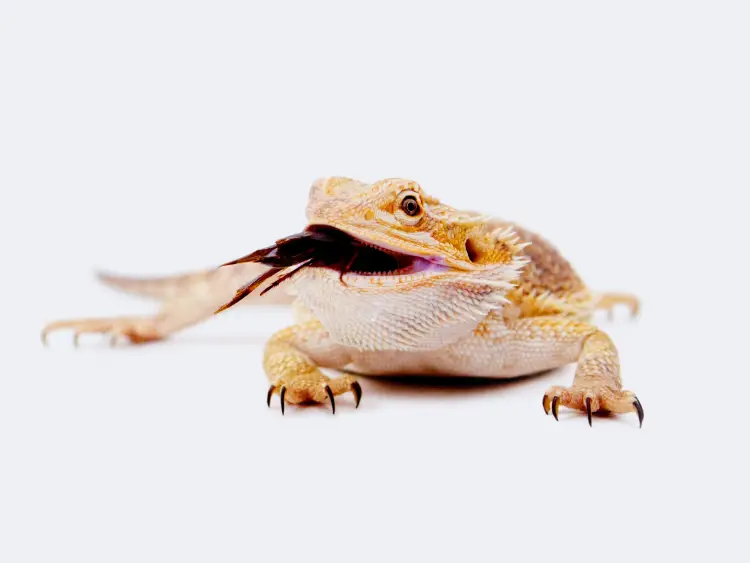
Caring for a baby bearded dragon is an exciting journey that requires specific knowledge about its nutritional needs. Among the most important aspects of a baby bearded dragon’s diet is the number of crickets they should be fed daily.
Providing the optimal amount of crickets can ensure proper growth and overall health for these adorable reptiles.
As baby bearded dragons grow, their dietary requirements change and it’s important to understand these stages. For instance, babies aged 0-4 months may consume up to 50-60 crickets per day, with the number of feedings decreasing as they reach adulthood.
During this time, appetite and cricket consumption naturally fluctuate, but consistent feeding sessions can support their rapid development.
Understanding Bearded Dragon Diet
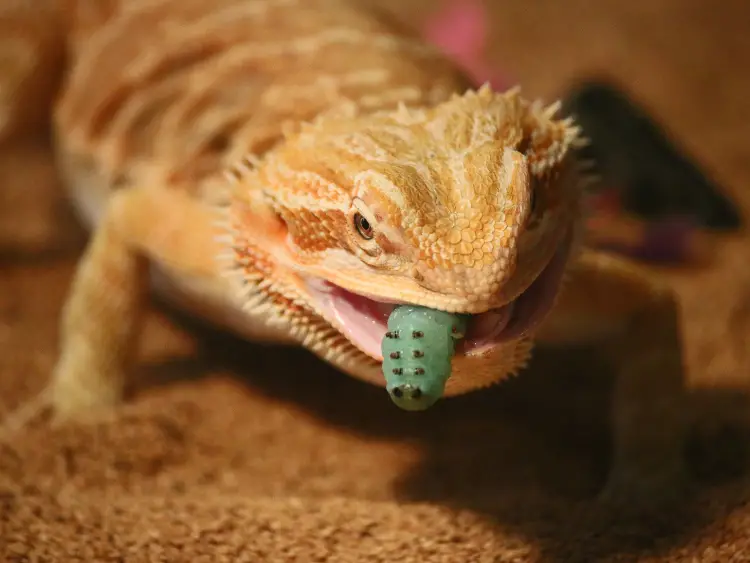
Bearded dragons are popular pets due to their unique appearance and friendly nature. Providing a balanced diet is crucial for their health, growth, and well-being. In this section, we will discuss the dietary needs of bearded dragons at different life stages – baby, juvenile, and adult.
Baby Bearded Dragon Diet
A baby bearded dragon’s diet consists primarily of insects, with a focus on protein for rapid growth. In fact, most baby bearded dragons consume 25-80 crickets daily among multiple feeding sessions.
Baby dragons should also be introduced to vegetables and greens early, with roughly 20% of their diet consisting of these items. Some key aspects of their diet include:
- Insects: Offer crickets, mealworms, or other insects, usually 80% of their diet.
- Vegetables and Greens: Start introducing leafy greens and veggies to make up 20% of their diet.
- Calcium: Dust insects with a calcium supplement to support proper bone development.
- Vitamins: Include a multivitamin supplement once or twice per week.
Juvenile Bearded Dragon Diet
As bearded dragons grow, the focus of their diet shifts from protein to a more balanced mix of protein and vegetables. By 3 to 12 months, juvenile bearded dragons should be fed 2-3 times a day. A juvenile’s diet generally consists of the following:
- Insects: Lower the protein intake by offering insects only 1-2 times per day.
- Vegetables and Greens: Provide fresh veggies and leafy greens more prominently in their diet.
- Calcium: Continue to dust insects with a calcium supplement.
- Vitamins: Maintain the use of a multivitamin supplement once or twice per week.
Adult Bearded Dragon Diet
Adult bearded dragons have a significantly different diet than their younger counterparts. Vegetables and greens become more important, while insects are provided in moderation. An adult bearded dragon’s diet typically consists of:
- Insects: Decrease protein intake further by offering 10-20 crickets per feeding 2-3 times per week.
- Vegetables and Greens: Fresh veggies and leafy greens should now make up 80% of their diet.
- Calcium: Continue to dust insects with a calcium supplement, but reduce the frequency to 1-2 times per week.
- Vitamins: Adjust the multivitamin supplement to once per week.
By understanding the dietary needs of bearded dragons at various life stages, you can ensure their optimal health, growth, and happiness throughout their lives.
Remember to stay informed and monitor your bearded dragon’s appetite, weight, and growth to keep them in the best possible condition.
How Many Crickets to Feed a Baby Bearded Dragon
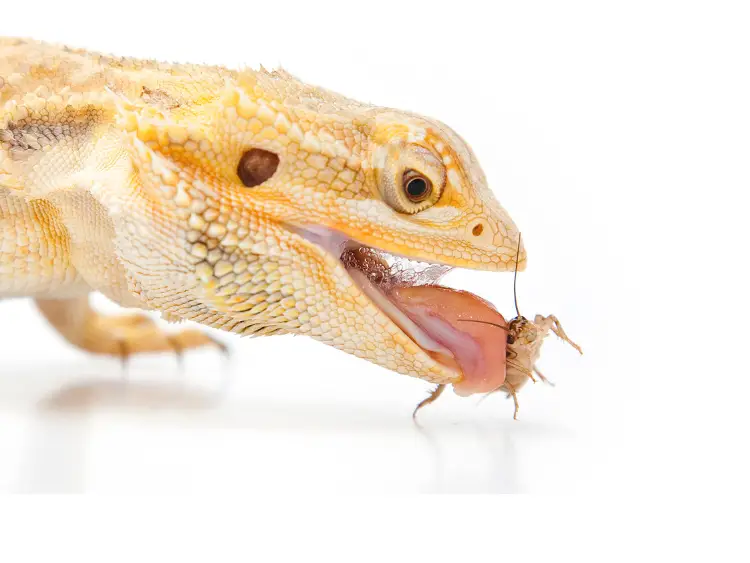
Feeding Frequency
Feeding a baby bearded dragon the right amount of crickets is essential to ensure proper nutrition and growth. Baby bearded dragons require a higher cricket consumption compared to adults, with some babies consuming between 25 and 80 crickets per day.
This high feeding frequency provides the necessary protein and energy for rapid growth. Be sure to provide several feeding sessions for your baby bearded dragon throughout the day to satisfy its appetite and promote optimal health.
Size and Age Considerations
The size and age of your baby bearded dragon will determine the size and number of crickets you feed it. For instance, 0-4 month-old baby dragons may eat up to 50-60 crickets per day, whereas older ones might need fewer.
When it comes to cricket size, it is important to feed your baby bearded dragon appropriately sized crickets to avoid choking hazards and digestive issues. For very young bearded dragons, pinhead crickets are recommended, while slightly larger small crickets are ideal for slightly older ones.
Feeding Chart
A feeding chart can be a helpful tool to ensure proper nutrition for your baby bearded dragon. The following table provides a general guideline on how many crickets to feed a baby bearded dragon based on age:
| Age of Bearded Dragon | Number of Crickets per Day | Cricket Size |
|---|---|---|
| 0-1 month | 50-60 | Pinhead |
| 1-3 months | 40-50 | Small |
| 3-4 months | 30-40 | Small |
Keep in mind that individual bearded dragons may have different appetites and nutritional needs, so it’s essential to monitor your pet’s growth and adjust the feeding regimen accordingly. Regularly consult with a reptile veterinarian to ensure your bearded dragon stays happy and healthy.
Variety in Diet
While crickets are an essential part of a baby bearded dragon’s diet, it’s also important to offer a variety of nutritious options to promote overall health and well-being.
Dubia Roaches
Dubia roaches are a great alternative to crickets as they provide a high protein content and are easy to digest. Additionally, these roaches are packed with nutrients such as iron, calcium, and vitamin B12. Introduce Dubia roaches gradually into the baby bearded dragon’s diet, making sure to monitor their consumption and overall health.
Worms
Worms, such as mealworms and waxworms, can serve as tasty treats for a bearded dragon, while also offering essential nutrients. However, it’s crucial to offer worms in moderation, as they are high in fat and can contribute to obesity if consumed too frequently.
Leafy Greens
Leafy greens are an important source of vitamins and minerals for baby bearded dragons. Options like collard greens, mustard greens, and kale should be introduced early in their life to help encourage their consumption as they grow older. These greens provide essential nutrients like iron, calcium, and fiber.
Fruits
Fruits make a great addition to your baby bearded dragon’s diet, offering a natural source of vitamins and antioxidants. Some suitable fruit choices include apples, oranges, and raspberries.
Be sure to chop fruits into small, manageable pieces and only feed them to your dragon occasionally, as excessive fruit consumption can cause digestive issues.
Vegetables
Incorporating vegetables into a bearded dragon’s diet provides additional nutrients necessary for their overall health. Some ideal vegetables for baby bearded dragons include squash, bell peppers, and green beans.
Make sure to cut these vegetables into small pieces and add them to their diet gradually, allowing time for their digestive systems to adjust.
By offering a variety of nutritious food options such as Dubia roaches, worms, leafy greens, fruits, and vegetables, you’ll ensure proper nutrition and set your baby bearded dragon up for a healthy and happy life.
Feeding Tips and Techniques
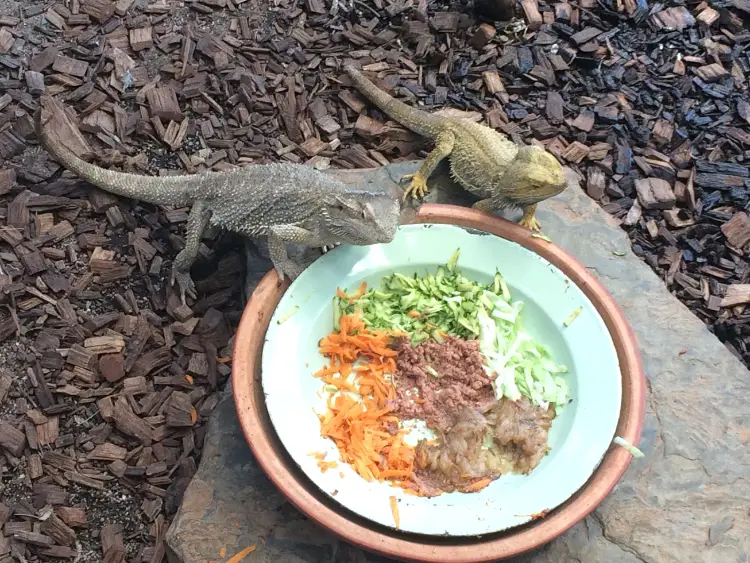
Feeding your bearded dragon the right amount and type of food is essential for its growth and overall health. When it comes to the number of crickets to feed a baby bearded dragon, it is important to consider their age and size.
Generally, baby beardies between 0-4 months of age require around 20-30 crickets per feeding session, while those between 4-6 months may need 10-15 crickets. These numbers may vary depending on the individual dragon’s appetite and activity level.
Offering appropriately sized crickets is crucial to ensure easy consumption and digestion. Baby or small crickets are suitable for younger dragons, while larger crickets can be introduced as they grow.
Remember to provide a varied diet by including other feeder insects, such as dubia roaches, in their meal plan. This helps prevent nutritional deficiencies and encourages a balanced diet.
To maintain a healthy feeding routine, establish a regular feeding schedule. Feeding your baby bearded dragon 2-3 times a day is recommended, allowing them to consume the required nutrients. Additionally, make sure to offer fresh water in a shallow water dish for hydration.
While crickets are an excellent source of protein for your baby bearded dragon, providing additional nutritional supplements is essential. Dusting the crickets with calcium and vitamin D3 powder before feeding ensures they receive essential nutrients for proper growth and development.
Always monitor your baby dragon’s feeding sessions and observe any signs of digestive issues or health concerns. If you have any doubts or questions about the feeding process, consult a reptile veterinarian or experienced bearded dragon owners for guidance.
Remember, providing a balanced and nutritious diet, appropriate-sized crickets, and following a feeding schedule tailored to your baby bearded dragon’s needs will contribute to its healthy growth and overall well-being.
Gut Loading Crickets
Before feeding crickets to your baby bearded dragon, it’s essential to gut load them for at least 24 hours. Gut loading enriches the crickets with additional nutrients that your bearded dragon needs for optimal health. Provide a high-quality gut load comprising dark leafy greens, vegetables, and fruits.
Supplements
Supplementing your baby bearded dragon’s diet is crucial for their development. Dust the crickets with calcium powder 5 times a week and with a vitamin D3 supplement twice a week. Also, use a multivitamin supplement once a week.
These supplements ensure your bearded dragon receives essential vitamins and nutrients that promote strong bones and overall health.
Hand-Feeding
Hand-feeding your baby bearded dragon can help establish trust and build a bond between you and your pet. To hand-feed, place a few crickets in a small container, dust them with the necessary supplements, and carefully offer them to your bearded dragon with a pair of tweezers or your fingers. Be patient and gentle during this process to avoid stressing your pet.
Building Trust and Bond
Building trust and a strong bond with your baby bearded dragon is essential for their emotional well-being. Spend time interacting with your bearded dragon and provide a calm, secure environment for them.
Frequent hand-feeding, gentle petting, and slow, deliberate movements when interacting with your pet can help establish trust and promote a healthy, happy relationship with your bearded dragon.
How Many Crickets To Feed Bearded Dragons? Watch this
Common Health Issues and Solutions
Impaction
Impaction is a common issue for baby bearded dragons, occurring when their digestive system becomes blocked due to the consumption of substrate or improperly sized food items. To prevent impaction, ensure all food items are no larger than the space between the dragon’s eyes, and use a suitable flooring material in their enclosure.
A warm bath and gentle belly massage may help alleviate impaction if your bearded dragon appears constipated or has difficulty defecating. However, if the issue persists, consult a reptile veterinarian for further guidance.
Parasites
Parasitic infections, such as coccidia and pinworms, can occasionally affect baby bearded dragons. Poor hygiene and contaminated food sources can increase the risk of parasite infestations. Regularly clean the dragon’s enclosure, and always wash your hands before and after handling to minimize the risk.
Signs of parasitic infection include lethargy, weight loss, and diarrhea. A fecal test performed by a veterinarian can confirm if your bearded dragon has parasites, and they can prescribe the appropriate medication for treatment.
Obesity
Overfeeding and providing an improper diet can lead to obesity in bearded dragons, causing health issues such as fatty liver disease, joint problems, and heart disease. Monitor your dragon’s weight regularly and adjust its diet accordingly, feeding them a balanced and appropriate diet.
Vitamin and Mineral Deficiencies
Baby bearded dragons require a diet rich in calcium, vitamin D3, and other essential vitamins and minerals for proper growth and development. Calcium and vitamin D3 deficiencies can lead to metabolic bone disease, which manifests as deformities, muscle weakness, and lethargy.
To ensure proper nutrition, dust the crickets or other insects with a high-quality calcium and vitamin D3 supplement before feeding. Also, provide a variety of greens in their diet to avoid nutrient imbalances.
Remember to use a UVB light in your bearded dragon’s enclosure, as this helps them synthesize vitamin D3, which is crucial for calcium absorption. Regular checkups with a reptile veterinarian are crucial for monitoring your bearded dragon’s overall health and detecting any deficiencies early on.
Enclosure and Environmental Factors
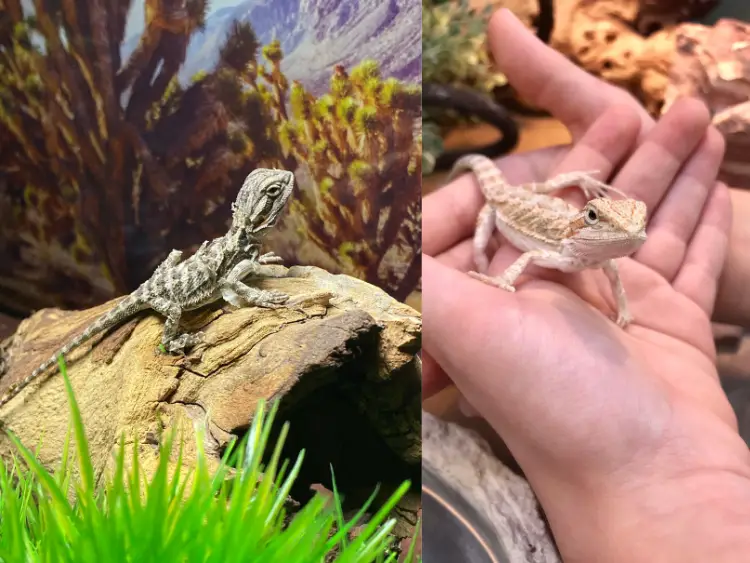
Temperature
Maintaining a proper temperature gradient within their enclosure is essential to ensure the proper growth and digestion of baby bearded dragons. During the day, the basking spot should be about 100-110°F (38-43°C), while the cool side should be between 75-85°F (24-29°C).
At night, the temperature should not fall below 65°F (18°C). Keeping the right temperature enables them to regulate body heat and efficiently digest food.
You can use digital thermometers or infrared temperature guns to monitor the temperature in different parts of the enclosure. Ceramic heat emitters or under-tank heaters are effective options to provide adequate heat for your baby bearded dragon.
Lighting
Proper lighting is crucial to a baby bearded dragon’s overall health. They require exposure to ultraviolet (UV) light, specifically UVA and UVB, to synthesize essential vitamins and calcium.
Install a UVB bulb within 12 inches of the basking spot, ensuring that it covers at least two-thirds of the enclosure. Ensure the bulb is replaced every six months to maintain its effectiveness. In addition to UVB light, a simple white light bulb should also be used to imitate natural sunlight.
Activity and Exercise
Providing a stimulating environment and opportunities for activity and exercise is essential for your baby bearded dragon’s physical and mental health. Encourage exploration and climbing by incorporating various elements in the enclosure, such as:
- Branches, ramps, or vines for climbing
- Rocks or logs for hiding and basking
- Different levels of elevation within the habitat
Regularly rearrange or replace these elements to keep the environment engaging and prevent boredom.
Digestion
Enclosure temperature and lighting play crucial roles in aiding the digestion process of baby bearded dragons. Maintaining appropriate temperatures and lighting conditions allows them to effectively break down their food, including crickets, which contributes to their overall growth and health.
Remember always to keep the enclosure clean, well-ventilated, and secure to provide a suitable and healthy space for your baby bearded dragon to thrive.
Conclusion: How Many Crickets to Feed a Baby Bearded Dragon
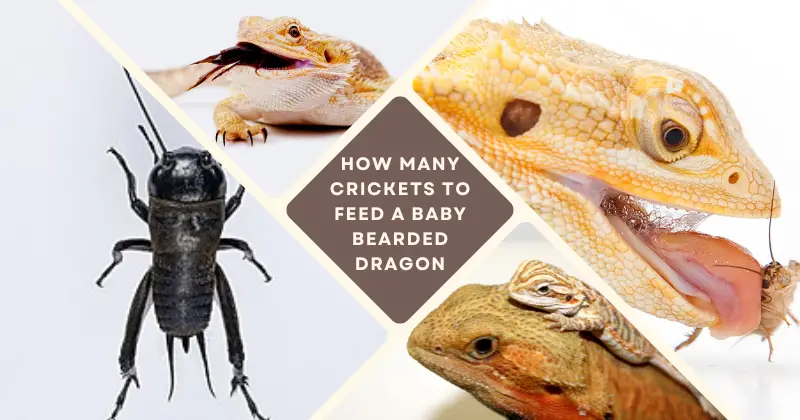
In conclusion, ensuring the right feeding approach for your bearded dragon is crucial for its overall health and well-being. By considering factors such as the size of crickets, feeding times, and your pet’s nutritional requirements, you can create a balanced and healthy diet.
Providing larger crickets in appropriate sizes during each feeding session, which typically lasts for 10-15 minutes, allows your dragon to consume the necessary nutrients. To maintain a nutritious diet, remember to vary their diet with other food sources, including vegetables and greens.
Monitoring their feeding habits, bowel movements, and overall activity level is important to ensure they are thriving. Additionally, seek advice from reputable sources, such as pet stores or experienced bearded dragon owners, to gain more insights into the specific needs of your dragon.
By following a proper feeding schedule and offering a varied and nutritious diet, you can support the growth and development of your bearded dragon throughout its life stages.
